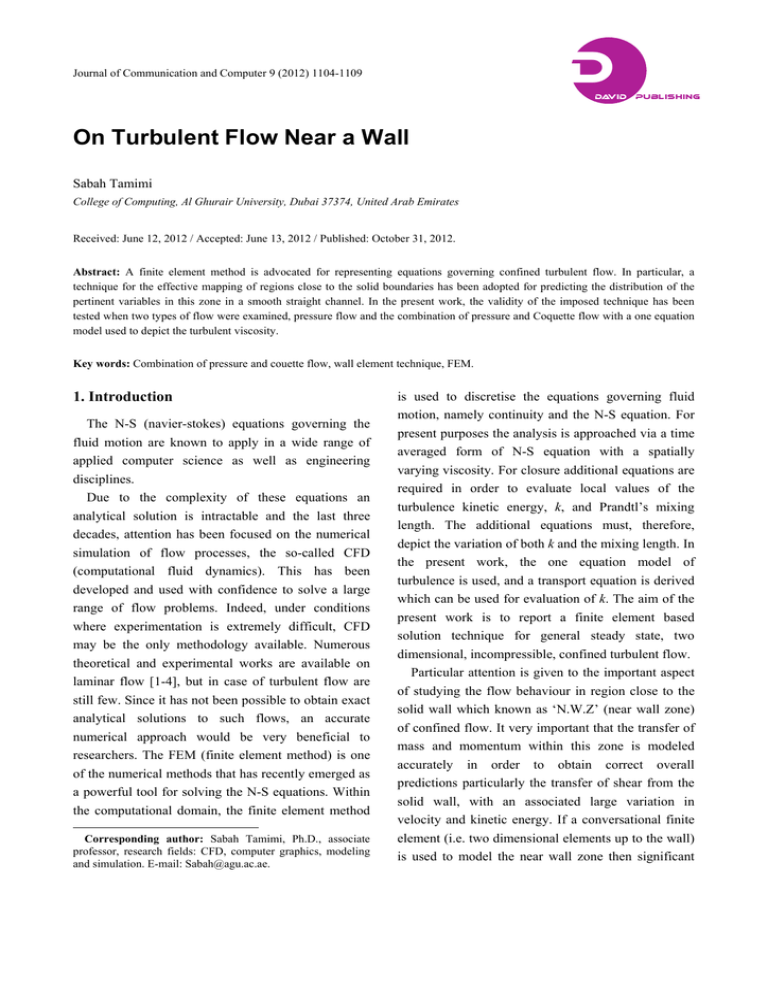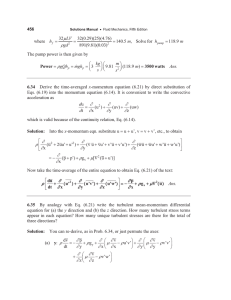On Turbulent Flow Near a Wall
advertisement

D Journal of Communication and Computer 9 (2012) 1104-1109 DAVID PUBLISHING On Turbulent Flow Near a Wall Sabah Tamimi College of Computing, Al Ghurair University, Dubai 37374, United Arab Emirates Received: June 12, 2012 / Accepted: June 13, 2012 / Published: October 31, 2012. Abstract: A finite element method is advocated for representing equations governing confined turbulent flow. In particular, a technique for the effective mapping of regions close to the solid boundaries has been adopted for predicting the distribution of the pertinent variables in this zone in a smooth straight channel. In the present work, the validity of the imposed technique has been tested when two types of flow were examined, pressure flow and the combination of pressure and Coquette flow with a one equation model used to depict the turbulent viscosity. Key words: Combination of pressure and couette flow, wall element technique, FEM. 1. Introduction The N-S (navier-stokes) equations governing the fluid motion are known to apply in a wide range of applied computer science as well as engineering disciplines. Due to the complexity of these equations an analytical solution is intractable and the last three decades, attention has been focused on the numerical simulation of flow processes, the so-called CFD (computational fluid dynamics). This has been developed and used with confidence to solve a large range of flow problems. Indeed, under conditions where experimentation is extremely difficult, CFD may be the only methodology available. Numerous theoretical and experimental works are available on laminar flow [1-4], but in case of turbulent flow are still few. Since it has not been possible to obtain exact analytical solutions to such flows, an accurate numerical approach would be very beneficial to researchers. The FEM (finite element method) is one of the numerical methods that has recently emerged as a powerful tool for solving the N-S equations. Within the computational domain, the finite element method Corresponding author: Sabah Tamimi, Ph.D., associate professor, research fields: CFD, computer graphics, modeling and simulation. E-mail: Sabah@agu.ac.ae. is used to discretise the equations governing fluid motion, namely continuity and the N-S equation. For present purposes the analysis is approached via a time averaged form of N-S equation with a spatially varying viscosity. For closure additional equations are required in order to evaluate local values of the turbulence kinetic energy, k, and Prandtl’s mixing length. The additional equations must, therefore, depict the variation of both k and the mixing length. In the present work, the one equation model of turbulence is used, and a transport equation is derived which can be used for evaluation of k. The aim of the present work is to report a finite element based solution technique for general steady state, two dimensional, incompressible, confined turbulent flow. Particular attention is given to the important aspect of studying the flow behaviour in region close to the solid wall which known as ‘N.W.Z’ (near wall zone) of confined flow. It very important that the transfer of mass and momentum within this zone is modeled accurately in order to obtain correct overall predictions particularly the transfer of shear from the solid wall, with an associated large variation in velocity and kinetic energy. If a conversational finite element (i.e. two dimensional elements up to the wall) is used to model the near wall zone then significant On Turbulent Flow Near a Wall grid refinement would be required which would be very costly in both computer storage and CPU time. In order to avoid such excessive refinement, several solution techniques have been suggested [5-7]. The more common approach is to terminate the discretised domain (main domain) at some small distance away from the wall ‘near wall zone’, where the gradients of the independent variables are relatively small. One of them is the so-called universal laws. In present work, one dimensional finite element technique (i.e. one dimensional element in one direction normal to the solid wall) has been used. The validity of this wall element technique has been tested and proved in the previous work [8] when pressure flow was considered. In this paper, wall element technique has proved again its validity when a combination of pressure and Coquette flow was considered. 2. Governing Equations The current investigation relates to steady—state incompressible two dimensional turbulent flow of a Newtonian viscous fluid with no body forces acting. For such a situation, the N-S equations associated with this type are which are, p ui =+ x j x j xi u u j (1) e i x j x i where i,j= 1, 2. ui, p are the time-averaged velocities uj and pressure respectively, is the fluid density, e is the effective viscosity which is given by e = + t, and t are the molecular viscosity and turbulent viscosity, respectively. The flow field must satisfy the continuity equation, which may be written as: ui = 0 x i (2) Eqs. (1) and (2) can not be solved unless a turbulence closure model can be provided to evaluate the turbulent contribution to e . The simplest model is via an algebraic formula [9] which has limited application and therefore this model is not adopted in 1105 the present work, but an alternative Prandtlkolmogorov [10] model is used in which, t C k 1 / 21 (3) 1 is the length scale of turbulence which obtained by 2.5*1m , where 1m is the mixing length based on the prandtl hypothesis which has been specified algebraically for the present purposes as 0.4 times the normal distance from the nearest wall surface, C is a constant and k is the time-averaged turbulence kinetic energy. The t given by Eq. (3) requires that k to be known. This can be evaluated via a further transport equation given by: uj k t k ui ui uj t B (4) xj xj k xj xj xj xi where B = C D k 3 / 2 /1 , t / k is the turbulent diffusion coefficient, k is the turbulent prandtl and CD is a constant. The turbulence model based on equations (1-2) and (4) is called the one-equation (k-l) model. Within the main domain the above governing equations have been discretised by using the standard finite element method [11-12] and Galerking weight residual approach is adopted to solve the discretised equations using quadratic 8-nodded elements to define the variations in velocities and turbulent kinetic energy, and linear 4-nodded elements used for the pressure. Greens theorem is used then to reduce the order of the equations to unity resulting in a “weak formulation” which resulted in non-linear equations matrix which is solved by either a coupled or an uncoupled method. 3. Near Wall Zone Modeling Techniques Within the near wall zone different techniques were used (Fig. 1), these are as follows, (1) Conventional finite elements (i.e.2-D elements up to the wall) are used to discretise the N.W.Z. and the variable values, following analysis, are used as reference data. However an excessive mesh On Turbulent Flow Near a Wall 1106 refinement was needed which is expensive in computer time and memory. (2) In order to avoid such excessive refinement, semiempirical equations, known as “Wall Functions” or the so-called “Universal Laws” [13], are used to bridge from a solid boundary to the main domain. (3) In the present work, a finite elements technique has been adopted, using one-dimensional (3-nodded elements) normal to the wall (Fig. 2). 4. Boundary Conditions In the present work, two types of fully developed turbulent flow are considered. These are pressure (i.e. both walls of the channel are fixed) and pressure plus Couette flow pressure (i.e. one of the walls is moving and the other one is fixed), in our case the upper wall is moving and the lower wall is fixed. In both, fully developed Dirichlet conditions are assumed on all variables upstream. No slip condition were imposed on solid boundaries and tractions updated downstream. Tractions are given by, x p 1 x 2 e u1 x1 x1—parallel to walls e u2 u1 x2—normal to walls x1 x2 5. Results and Discussion Full developed turbulent flow was considered in a parallel-sided duct of width D, which is taken as 1.0 in the present work, and length L. Compatible fully developed velocity and kinetic energy profiles were imposed as initial upstream values. These profiles were obtained by using the outlet values form each iteration as new approximation to the values at the inlet until a converged condition is satisfied. Different Reynolds number based upon the width of the channel of 70.000, 50.000 and 12.000 were considered. Fig. 1 Boundary conditions when the mesh is terminated at small distance away from the wall. Fig. 2 One-dimensional elements in one-direction normal to the wall used in the N.W.Z. On Turbulent Flow Near a Wall The first example was concerned with an analysis of pressure flow where both walls of the duct were fixed. Fig. 3 clearly shows that the velocity values obtained by universal profiles have some discrepancy from those obtained from the advocated wall element technique (i.e. one-dimensional element in one direction). Again, the results obtained from the adoption of the presently advocated technique exhibits excellent agreement with the correct solution which resulted from the complete mapping (i.e. two-dimensional element up to the wall) as shown in Fig. 4. These are, superior to those obtained using universal laws. Fig. 5 shows excellent agreement between the imposed technique and experimental results [14]. Once more, the “correct” values are remarkably close to those obtained from the proposed technique, 1107 as shown in Fig. 6 which refers to the kinetic energy profile. Obviously the results obtained from the adoption of 1-D elements in one direction is still the most advantageous owing to the number of elements used in the near wall zone. The second example was concerned with an analysis of combining pressure and Couette flow, with the lower surface stationary and upper surface moving at a constant speed. Fully developed turbulent velocity profiles and turbulent kinetic energy distribution for a Reynolds number of 70.000 were obtained and presented in Figs. 7 and 8, respectively, these show comparisons with universal laws and experimental results [14]. Once more, the results obtained from the adoption of the wall element technique are significantly better than those obtained using the universal laws, and compare favourable with experimental results. Fig. 3 Turbulent velocity profiles for fully-developed flow, at 8D downstream, L = 8D, Re = 50.000. Fig. 4 Turbulent velocity profiles for fully-developed flow, at 8D downstream, L = 8D, Re = 12.000. 1108 On Turbulent Flow Near a Wall Fig. 5 Turbulent velocity profiles for fully-developed flow, at 8D downstream, L = 8D, Re = 50.000. Fig. 6 Kinetic energy profiles for fully-developed turbulent flow, at 8D downstream, L = 8D, Re = 12.000. Fig. 7 Turbulent velocity profiles for fully-developed for turbulent flow with fixed lower surface and moving upper surface, at 8D downstream, L = 8D, Re =70.000. On Turbulent Flow Near a Wall 1109 Fig. 8 Turbulent fully-developed kinetic energy profiles for turbulent flow with fixed lower surface and moving upper surface, at 8D downstream, L = 8D, Re = 70.000. 6. Conclusions The utilization of universal laws is not valid since these laws are only really applicable for certain one dimensional flow regimes. Also, the use of 2-D elements up to the wall is not economically viable. Therefore to avoid such an excessive refinement, these methods have been replaced by introducing a finite element wall element technique which has shown more advantages comparing to these methods. The validation of the wall element technique has been proved again its validity with case of the combination of pressure and couette flow. Therefore, this technique can be used with confidence for fully-developed turbulent flow. [5] [6] [7] [8] [9] [10] References [1] [2] [3] [4] C.L. Wiginton, C. Dalton, Incompressible laminar flow in the entrance region of a rectangular duct, J. Apple. Mech. 37 (1970) 854-856. E.M. Sparrow, C.W. Hixoin, G. Shavit, Experiments on laminar flow development in ractangular duct, J. Basic Eng. 89 (1967) 116-124. D.M. Hawken, H.R. Tamaddon-Jahromi, P. Townsend, M.F. Webster, A taylor-galerkin based algorithm for viscous incompressible flow, Int. Journal Num. Meth. Fluids (1990). A.K. Mehrotra, G.S. Patience, Unified entry length for [11] [12] [13] [14] newtonian and power law fluids in laminar pipe flow, J. Chem. Eng. 68(1990) 529-533. B.E. Launder, N. Shima, Second moment closure for near wall sublayer: Development and application, AIAA Journal 27 (1989) 1319-1325. S. Engelman, On modeling wall-bound turbulent flows using specialized near-wall finite elements and the standard k- turbulent model, Advances in Num. Simulation of Turbulent flows 117 (1991) 97-105. T. Graft, A. Gerasimov, H. Iacovides, B. Launder, Progress in the generalization of wall-function treatments, Int. Journal for Heat and Fluid Flow (2002) 148-160. S. Tamimi, An effective technique using finite element methods, International Journal of Electrical & Computer Science IJECS-IJENS 12 (2012) 1-5. B.E. Launder, D.B. Spalding, Lectures in Mathematical Models of Turbulence, Academic Press, 1972. A.H. Kolmogrov, Equations of turblent motion of an incompressible fluid, SSSR Ser. Phys 1-2 (1942) 56-58. C. Taylor, T.G. Hughes, Finite Element Programming of the Navier-Stokes Equation, Pineridge Press, 1981. Zienkiewicz, O.C. and Taylor, R.L., The finite element method, McGraw-Hill, 1988. T.J. Davies, Turbulent Phenomena, Academic Press, 1972. U.S.L. Nayak, S.J. Stevens, An Experimental Study of the Flow in the Annular Gap Between a Long Vehicle and a Low Close-Fitting Tunnel, Report, Dept. of Technology, Loughborough University of Technology, 1973.


